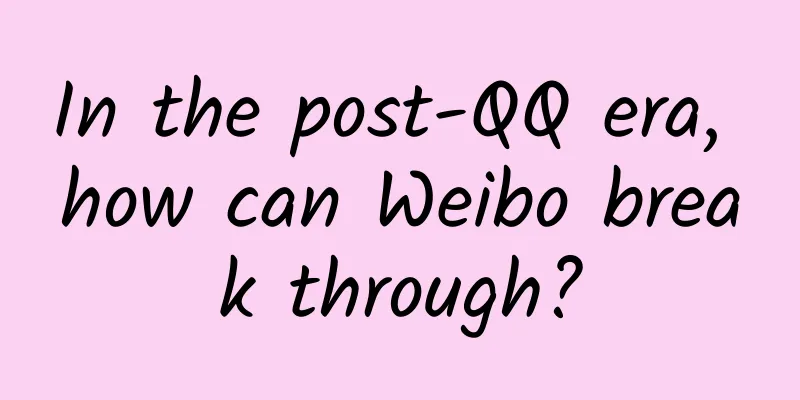In the post-QQ era, how can Weibo break through?

|
What would Weibo be like now if WeChat had not appeared? Weibo CEO Wang Gaofei’s answer is: It is very likely to face the same problem as Kaixin.com did back then, that is, it will be difficult to expand to second-tier and third-tier cities and below. "If WeChat hadn't become popular, Tencent would not have given up Tencent Weibo. Users in most parts of China would still use Tencent Weibo. Although Sina Weibo would be very comfortable in first-tier cities, it would not be able to penetrate into second-tier or third-tier cities. It might have reached an MAU (monthly active users) of 60 to 70 million and never went up again, just like Kaixin.com reached an MAU of 30 million and never went up again." Wang Gaofei said this in his office in Ideal International Building when talking about WeChat, a competitor that almost everyone asks about. But the rise of WeChat has brought about another competitive situation—— Previously, in the second- and third-tier markets and even deeper levels, Tencent had already built a closed wall based on QQ. Almost all the needs of netizens could be met within this wall. This was also the foundation of Tencent. Even the once popular Kaixin001 failed outside the wall. However, with the advent of the mobile Internet era, cracks began to appear in this originally unbreakable wall, and the rise of Tencent WeChat made the cracks open faster, and the post-QQ era arrived. When the original QQ wall was broken, other competitors were finally able to compete with Tencent for the second and third tier markets, and Weibo's next opportunity arrived. Wang Gaofei also responded to questions such as Weibo's development in the past year, how he views the competition with Tencent's WeChat, where Weibo's future growth space lies, how to expand into second- and third-tier cities, how to integrate the Internet with traditional industries, commercialization, future investment directions, etc. Post-QQ era? Has Weibo declined under the impact of WeChat? Sina Weibo responded with several sets of figures in its financial report: throughout 2014, Weibo's monthly active users increased by 47 million, setting a record since its birth in 2009; the number of monthly active users reached 176 million, and the number of daily active users reached 81 million, of which the proportion of monthly active users on mobile devices reached 80%. In addition to the market space created by the withdrawal of competitors such as Tencent Weibo and NetEase Weibo, where do Sina Weibo's 47 million new active users mainly come from? Before answering this question, Wang Gaofei told me that when talking about the social market with some investors, everyone called the past two years the "post-QQ era." In their view, QQ is actually a closed wall. The wall is very high, and they have the final say on what flowers to plant or grow inside the wall, because my experience is better than all of yours, including QQ Space, Tencent Weibo, video and other various businesses, which are actually grown inside the QQ wall. "But now that WeChat has become popular, we see that QQ has directly torn down the wall on the most basic communication products. When you look at the QQ client now, it no longer has Qzone, Tencent Weibo, etc. QQ has returned to the most familiar communication field. In second- and third-tier cities, only if QQ gives up these, other Internet companies will have the possibility to enter." Wang Gaofei said. It is not difficult to understand where the new users of Weibo come from: some of the original QQ users have gone to WeChat Moments, some have gone to the separate Qzone client, and some have gone to Tencent's competitors, such as Weibo and Momo. "By 2016 at the latest, there will be a process of market reshuffle. If the users in second- and third-tier cities can be occupied, then they will be occupied. If not, there may be a new product to take over. This is also a major source of users for Weibo," said Wang Gaofei. How to tap into second- and third-tier users? At present, the penetration rate of Weibo in third-tier markets is less than one-third of that in first-tier cities, and only about half of that in second-tier cities. Wang Gaofei said that in 2015, Weibo will continue to increase its market investment in cities other than first-tier cities to accelerate the conversion of these users to Sina Weibo. Last year, Weibo sent two teams to spend half a year in Yibin, Sichuan and Jiujiang, Jiangxi, two third-tier cities with a relatively low proportion of Weibo users, and made some interesting discoveries. "Everyone was saying that the mobile Internet was on the rise, or that it had already ended, but later we found that it was far from the truth," said Wang Gaofei. Yibin has a population of about 4.5 million, and the number of mobile phone users is about 4 million. It is indeed saturated. 90% of people have mobile phones, but less than 500,000 people use more than 1 megabyte of data per month, and more than 3 million people have mobile phones but do not access the Internet. These findings led Weibo to make some adjustments to its products. For example, in order to attract these second- and third-tier users and young users, Sina Weibo strengthened its support for local big accounts and strengthened its cooperation with TV stations. In 2014, it cooperated with more than 20 satellite TV stations and more than 100 TV programs nationwide. The advantages in social media also made Weibo's cooperation with channels such as mobile phone manufacturers smoother, reducing the cost of user acquisition. As for the second- and third-tier user markets, Weibo has thought very clearly: the social needs of this type of users have basically been met by QQ and WeChat, so Weibo still focuses on satisfying the dissemination and sharing of user information. "The first group of loyal Weibo users in second-tier cities were those who had lived in first-tier cities and later returned to second-tier cities. The same is true for users in third-tier cities. These users follow and are interested in big microblogs, some professionals, or some self-media on Weibo. Most users in cities other than first-tier cities still focus on obtaining and sharing information when using Weibo." To this end, Weibo has shifted its product focus to the multimedia field. Since the end of the second quarter of last year, Weibo has begun to increase its investment in vertical information production, especially in the optimization of product experience in the production of original content such as pictures and videos. It has also launched independent video and picture clients through investment and other means. The increase in content producers, the improvement of products, and the increase in consumable content have driven the growth of new users. Exploring native advertising With the increase in the number of active users, Weibo achieved its first quarterly profit since its listing: net profit of US$9.4 million in the fourth quarter. What supports Weibo's profitability is largely the fact that customers are beginning to shift their advertising budgets to mobile advertising and social advertising, especially information flow advertising. Weibo's financial report shows that Weibo's mobile advertising revenue continued to grow in 2014, with the contribution ratio rising from 31% in the first quarter to 54% in the fourth quarter, nearly doubling from 28% in the same period last year. By the end of the fourth quarter, the number of small and medium-sized advertisers on Weibo exceeded 14,000, a month-on-month increase of 35%. The number of active users using Weibo's self-service advertising system exceeded 300,000 in the fourth quarter, a month-on-month increase of 94%. But Wang Gaofei admitted that there was a slight deviation between the advertising on Weibo and what was originally expected. "Information flow ads like those on Facebook and Twitter are relatively native. If you look at Facebook ads, you will find that the ads are mainly promoted on the official WeChat accounts of the clients, and then follow-up marketing is done on the official WeChat accounts. However, the scale of Weibo is still small, with less than 1 billion yuan of information flow ads last year. In fact, Weibo has not yet made brand clients accept large-image ads, and has not yet released small-image or text ads like the native Weibo ads. It will take time to cultivate the market." In addition, Weibo's current small and medium-sized customers basically come from Baidu or Taobao, and they value simple and direct pure effects the most. Therefore, Weibo is now facing a difficult task in market cultivation and promotion. Wang Gaofei said that currently it can only be promoted slowly by offering discounts on native advertising. In the domestic market, we can see that WeChat also officially entered the information flow advertising industry in January this year. "In fact, we hope to launch information flow advertising in WeChat Moments as soon as possible." Wang Gaofei said that under the joint promotion, if customers also present according to the native advertising system, the subsequent market cultivation will be much better, and the advertising experience of Weibo users will also improve accordingly. This also means that the "Taobao advertising column" that was once ridiculed by Weibo users may have a better way to be presented. Wang Gaofei predicts that when information flow advertising becomes the key area of focus for advertisers in the future, in the long run, the proportion of Alibaba advertising on Weibo may decline. 24 hours of competition for users In Wang Gaofei's eyes, Weibo's biggest competitor is not WeChat. At present, WeChat is still a relatively closed communication and social platform. Judging from the recent popular "White, Gold, Blue and Black" and the "Ice Bucket Challenge" that once swept the world, it is difficult to form global attention to the same thing through the closed network of WeChat Moments. "Of course, there is already competition between us and WeChat, and there is also a certain degree of competition in functionality, but at the core, what we are competing for is the users' 24 hours," said Wang Gaofei. A peak period for Weibo is from 8pm to 12am, when users spend a relatively concentrated amount of time using Weibo. However, during this time, the most popular client used by users in first-tier cities is video clients, while users in cities outside the first-tier cities mainly spend their time on mobile games. In order to better retain Weibo users, Wang Gaofei said that Weibo will increase investment in user information production in content products and vertical fields. The most efficient thing on Weibo is information dissemination, followed by information consumption, and then information production. When Weibo has to take care of tens of millions of users in information production, it is difficult to take care of some professional information such as videos and selfies. Therefore, Weibo invests in tools such as videos, pictures, and audio, and recommends them to users on Weibo who like these applications. "The requirements are very simple. Just recommend and share your information on Weibo. It's also beneficial to it because the more Weibo posts it shares, the more return traffic I will bring to it," said Wang Gaofei. Investments in other areas also include enhancing Weibo technology, such as advertising technology and big data analysis. In the O2O field where BAT has been scrambling to grab market share in the past year, Weibo has its own thoughts. In Wang Gaofei's eyes, if Weibo's O2O is defined as a platform for information dissemination or consumption, the first thing to consider is what Weibo can do with these platforms in offline information dissemination and consumption. For example, in terms of interaction with TV stations, Weibo believes that it has connected the mobile phone screen and the TV screen to some extent. In addition, Weibo is launching a series of offline cooperation with Focus Online. Focus Online has deployed a device in 80,000 offline screens across the country. This device can sense the Weibo users around it, reaching about 20 to 30 million users every day. When these users see the ads on the Focus Online screens, they will receive Weibo reminders and can receive red envelopes from merchants, etc. The two companies have started to try it out in early February this year, and the conversion rate is about 20%. Regardless of whether it is investing in content products, vertical fields or O2O layout, Wang Gaofei said that Weibo's primary consideration is not how to make money. For Weibo, increasing the number of users is ranked first, increasing user activity is ranked second, and revenue growth is ranked third. "If you say there is something that can increase my MAU by 20 million, but will cause me to lose money for three consecutive quarters, then I must do it." Wang Gaofei said affirmatively. As a winner of Toutiao's Qingyun Plan and Baijiahao's Bai+ Plan, the 2019 Baidu Digital Author of the Year, the Baijiahao's Most Popular Author in the Technology Field, the 2019 Sogou Technology and Culture Author, and the 2021 Baijiahao Quarterly Influential Creator, he has won many awards, including the 2013 Sohu Best Industry Media Person, the 2015 China New Media Entrepreneurship Competition Beijing Third Place, the 2015 Guangmang Experience Award, the 2015 China New Media Entrepreneurship Competition Finals Third Place, and the 2018 Baidu Dynamic Annual Powerful Celebrity. |
<<: Can Internet TV completely defeat traditional TV in one step?
>>: Lei Jun vs. Zhou Hongyi: A 20-year-long "battle between heaven and earth"
Recommend
Can ordinary people really make money through Douyin live streaming? Real cases speak for themselves
Self-media is very popular now, and many people w...
Practical Post | Comprehensive analysis of “Zhihu channel distribution strategy”!
My first impression of Zhihu came from a question...
The Earth is secretly "slowing down", and a day may be extended to 25 hours in the future?
Tuchong Creative Almost all celestial bodies in t...
A complete guide to selling goods in private domain "welfare groups"
Community is one of the necessary operating metho...
The reason I recommend you to eat more pears, just one is enough!
In the golden autumn, the weather is slightly dry...
7-day special training camp for WeChat public account traffic generation_Zhuofan Academy
7-day special training camp for WeChat public acc...
The official responded to the child being hung on a cliff to take pictures, and netizens commented: Install a guardrail, it feels super dangerous!
On July 12, beside Hongjing Road in Fangshan Dist...
The latest news on the epidemic in Tangshan, Hebei in 2022: Is Tangshan under lockdown? When will the ban be lifted?
Recently, the Omicron variant of the new coronavi...
Mobile APP development encounters bottleneck? What should developers do?
Editor's note: At present, there are enough m...
Hesai Technology's LiDAR was found to have a "leap year bug", and the company said it would solve the problem within 24 hours
It is reported that because Hesai Technology'...
LeTV Box U4 Pro turns old TV into super TV instantly
Among Internet TV brands, LeTV, which has sold 10 ...
Analysis of advertising strategies in the education franchise industry
The unexpected outbreak of the epidemic has broug...
Estimated time for Changchun City to be unsealed in 2022: When will it be fully unsealed? Attached are the conditions for lifting the lockdown!
According to the latest report, from 0:00 to 24:00...
How to write a website analysis report? How to write a website diagnostic analysis report?
For website optimization SEO practitioners, after...
The nine sons of a dragon don't look like dragons? I was torn when I knew the truth!
As the saying goes: The dragon has nine sons, eac...









